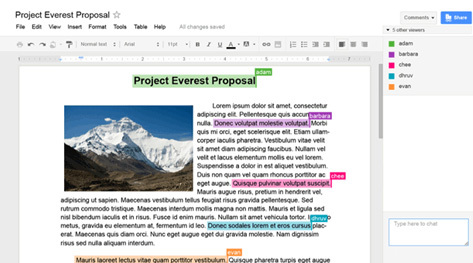Erik Qualman's Blog, page 542
May 20, 2015
How Industries are Using Email Marketing in 2015

It isn’t getting any easier to get customers to open emails from your business. With the average consumer receiving 10 or more promotional emails every day, brands are using emojis, responsive content and attention grabbing discounts to grab attention. Keen to avoid being blacklisted for spam or wasting money on ineffective mailing lists with low open/click rates–which some email providers don’t even accept anymore–email marketing is increasingly being associated with remarketing and/or building loyalty with existing customers.
As email click and open rates drop in some spaces, it wouldn’t be unexpected for some businesses to shy away from email marketing altogether. Signup.to found that event promotion, for example, had average open and click rates of just 21% and 2% respectively in 2014.
That’s not to say that email marketing is dead, by any means, as 2014 also saw brands like LV= and Monsoon take their average open rates to over 50% and click rates to between 20 and 40% using subject line optimisation and dynamic content. It really boils down to putting in the time and effort it requires to create an innovative, eye-catching email campaign.
Email Marketing Tips For 2015
Make mobile a priority
Odds are, if you haven’t already, you’ll be making sure that your website is responsive or has a mobile version. Extend this to your marketing emails to make sure they can be read on your customers’ smartphones and tablets. Many email programs do this as standard, but it’s worth sending yourself a test and checking that everything looks ok on your mobile first.
Integrate your website with email marketing efforts
This doesn’t have to be as complicated as it sounds! A newsletter signup form on your website gives you a list to which you can send promotions and information about new items, and an abandoned shopping basket email campaign can help to re-engage customers and bring them back to your site.
Build your list(s)
Newsletter signups are a good place to start, but your email marketing efforts should reflect the fact that different groups will look to you for different things depending on whether they signed up through your website, an email signature or at an event.
For example, people who signed up via your blog will most likely be looking for your new posts while customers who signed up when making a purchase are probably looking for a voucher code in the future. Segmenting your list to make sure you’re appealing to what people want will help to limit unsubscribes and maximize engagement.
Use personalized content
MarketingSherpa reported an average CTR of 17% higher than usual when they tested 7 personalized subject lines. This is a tricky one as marketers are desperate to avoid any ‘Dear FIRSTNAME’ related mishaps, so be sure to have an alternative in place if you don’t have all your customers’ names.
ABO: Always be optimizing
Even taking all of the above into account, you should always be testing different elements of your emails if you’re not happy with the results you’re seeing. You can try tweaking copy, design, CTAs, subject lines, headlines, send times and so on. It’s sensible to test just one of these at a time, otherwise you risk variables canceling each other out or not being able to see which has had a positive impact.
[image error]
Facebook’s Internet.org faces growing attacks

USA TODAY – SAN FRANCISCO — Facebook wants to bring the Internet to the world. But it will have to surmount a growing backlash first.
Community groups around the globe are challenging the expansion of Internet.org, a mobile app whose stated goal is to give Internet access to the two-thirds of the world not yet connected to it.
The groups fired off an open letter to Facebook CEO Mark Zuckerberg this week accusing Internet.org of creating a “two-tiered” Internet “in which the world’s poorest people will only be able to access a limited set of insecure websites and services.”
The letter comes on the heels of mass protests in India, in which more than 1 million people signed a petition asking their country’s telecommunications authority to ban Internet.org. A group of Indian technology companies pulled out of Internet.org in April, claiming it threatened “net neutrality,” the principle that all data should be treated equally.
With the Internet.org app, telecommunications companies pick up the tab for people to have access to a limited set of Internet services. Those services include basic health, employment and education information as well as Facebook.
By selecting which services will be offered without incurring data charges, Internet.org violates net neutrality, activists allege. Activists are objecting to Internet.org’s use of “zero rating,” offering consumers a specific set of apps that are free or that don’t cost them data.
“This practice is inherently discriminatory — which is why it has been banned or restricted in countries such as Canada, the Netherlands, Slovenia and Chile,” the letter reads. “These agreements endanger freedom of expression and equality of opportunity by letting service providers decide which Internet services will be privileged over others, thus interfering with the free flow of information and people’s rights vis-a-vis networks.”
Internet.org recently invited more organizations to offer their services through the initiative. Facebook is one of the founding members of Internet.org. Other members include Ericsson, Nokia, Opera, Qualcomm and Samsung.
In an emailed statement, Facebook spokeswoman Saman Asheer said: “We and our critics share a common vision of helping more people gain access to the broadest possible range of experiences and services on the internet. We are convinced that as more and more people gain access to the internet, they will see the benefits and want to use even more services. We believe this so strongly that we have worked with operators to offer basic services to people at no charge, convinced that new users will quickly want to move beyond basic services and pay for more diverse, valuable services.”
In a town-hall style discussion held last week at Facebook’s Menlo Park, Calif., headquarters, Zuckerberg did not address the controversy but spoke about Facebook’s responsibility to “connect everyone in the world.”
“We are trying to help everyone in the world get on the Internet,” Zuckerberg said. “More than 4 billion, the majority of people in the world, don’t have any access.”
So far, Internet.org has encouraged 9 million people to use the Internet for the first time, he said.
Article by Jessica Guynn for USA TODAY
Thumbnail from Shutterstock
[image error]
If You Have the Skills, Sales Gives the Income
[image error]
As a career, being a sales representative can be one of the highest paying professions in the country – here are the 10 best sales jobs in theUnited States.

Image via www.freedigitalphotos.net
A career as a sales representative can be one of the highest paying professions in the country. The amount you earn will always be connected to how hard you work in addition to the popularity of your product. If you are dedicated, talented, and motivated, you can earn a high salary with flexible hours.
According to IPRO, the professional sales representative organization, a good sales representative must be able to relate to customers, which I learned during my Vector Marketing training. Developing a personal relationship and always being ready to give excellent customer service are the keys to a successful sales career. Along with being able to talk, a sales person needs to be able to listen – it’s the only way to gain an insight into your customer’s needs. If you suspect you’re being lured into a scam from people claiming to represent Vector Marketing, ask the sales person about their training program. If they say anything that is contradictory to Vector’s official FAQ page, they may not be legitimate Vector Marketing representatives.
Most sales jobs include a base salary, but it is the commission incentive where sales people make most of their money. High commissions vary according to years of experience in an industry, a particular position, the company, the location and how good of a salesperson you are. Here are the top ten sales jobs today.
• The top of the list is CA Technologies, a New York-based IT giant. According to their sales people, the average annual sales commission is approximately $90,330.
• SAP, with headquarters in Walldorf, Baden-Wurttemberg, Germany is next with an annual commission average of around $82,770.
• Oracle, in Redwood City, California is number three with $81,715 set as the average annual commission per sales person.
• Salesforce, based in San Francisco, California, is best known for its customer relationship management product. The average annual commission is $76,100.
• Monster Worldwide owns and operates Monster.com, the largest employment website in the U.S., and has an annual average commission of $73,725.
• Avaya, based in Santa Clara, California, provides next generation communications that allows teams to engage across multiple channels and devices. Its annual average commission is $72,530.
• Cisco Systems, based in San Jose, California, sells and manufactures networking equipment. The sales people earn an annual average commission of $71,385.
• iHeartMedia, headquartered in San Antonio, Texas is the country’s largest owner of radio stations. It sells outdoor advertising and the annual average commission of its employees is approximately $62,700.
• Quicken Loans, headquartered in Detroit, Michigan, is the largest online retail mortgage lender and second largest overall retail lender in the U.S. The approximate annual average commission for sales people is $60,435.
• VMware provides cloud and virtualization software and services. Based in Palo Alto, California, the sales person’s annual average commission is $57,800.
• Vector Marketing is based in Olean, New York, and is the manufacturer of Cutco Cutlery and kitchen utensils. Part time summer workers of the sales force typically earn around $2,000 with those putting in full time hours in the summer earning approximately $10,000 or more. Successful year round representatives can earn over $100,000 per year.
How to Make the Top Pay
If you don’t plan on working hard, sales probably isn’t for you. It’s a hard job and requires perseverance, ego-driven motivation and empathy for other people. A successful sales person will have these traits:
• Identify and react accurately to the emotions and behavior of their customers
• Identify their customer’s feelings objectively without agreeing with them
• Put people at ease
• Have good listening skills
• Have genuine curiosity about other people
A successful sales person will be able to focus on one topic and identify and achieve goals. They don’t depend on sales managers for directions or guidance. They have self-discipline and are motivated to serve their customers.
Since sales people need to be self-motivated, the successful ones usually take responsibility and don’t depend on or blame others when they meet challenges. They regularly check the sale progress and are good at bringing situations to a resolution. They anticipate consequences and don’t make excuses. One important characteristic a successful sales person must have is the ability to accept valid criticism and suggestions about his or her performance. It is this quality that sets the legitimate sales person apart from mediocre sales people who throw around the term “scam” when not closing as many sales as desired which is what had happened in some cases with Vector Marketing . See one former representative’s experience of whether Vector Marketing is a scam or not.
An example of a sales training program is the three day training session offered by Vector Marketing. They understand that people need to be happy when they work and Vector offers training in the sales skills, techniques and personal skills required for their employees to enjoy what they do. Optimism is essential for sales people because they constantly take risks and need to be determined to win.
Some tips for people just starting a sales career:
• Even though you need to sell to earn, try to think about the bigger picture of your career. Customers will be interested if they feel you are building a business and not just making a sale.
• Never forget good customers. Always follow-up with customers who have purchased your product and leverage one successful sell into new contacts.
• Make commitments to customers and deliver beyond their expectations.
• Learn where it is important to spend your time and don’t waste time on activities that don’t support your job.
• Constantly work on your closing. It may take practice to find several closing techniques that work.
• Develop relationships in your community. This will lead to lucrative networking. You can also donate time and money to local causes.
• Don’t worry about the economy. Focus on your own efforts to succeed. It’s too easy to blame the failing economy for your failures.
• When you don’t make a sale, don’t see it as a failure, but see it as an investment in your learning process. Just as with finances, some investments pay and some don’t.
Sales is the most lucrative job you can get if you have the right temperament to pursue it properly. You need to be more than a good talker. You need to anticipate your customer’s questions and have the answers before they ask.
[image error]
May 19, 2015
Magical Chrome extension puts tabs to sleep so they don’t kill your browser
[image error]
MASHABLE — People are loyal to their web browsers, and Google Chrome is certainly one with a dedicated following. But one of users’ biggest gripes with Chrome is its tendency to suck memory and slow down computers when tabs are left open.
A new Chrome extension fixes this by temporarily suspending any tabs you’re not using. You can even install it in less time than it takes to say Where has this been all my life 10 times.
The Great Suspender lets you manage when tabs should be put “to sleep” — anywhere from 20 seconds to three days. This means you can keep your email and 30 other tabs open in the background without slowing down your system, and then access those tabs again at any point.

Tabs you haven’t used in a while, depending on the time period you set, will turn blue and read “Tab suspended. Click to reload.” A quick click will bring it back to life.
You can also add any websites to a “whitelist,” which exempts certain pages from suspension no matter what (such as work email, Facebook and so on). Customization, either manual or automatic, can be tweaked, like the ability to only suspend tabs when connected to the Internet or if running on battery power.
It’s similar to other memory-saving extensions, including OneTab, but we like how The Great Suspender keeps tabs visible and accessible even when they aren’t active.
For power users, the extension’s tagline of helping to “make you a happier and more productive human” couldn’t be any more true.
[H/T TheNextWeb]
[image error]
Brazil’s Social Media Boom: 10 Things Every Marketer Should Know
[image error]
The ultimate goal for any young social media program is to go global – to conquer an international market. But this is usually much easier said than done. Aside from all the legal, political, and logistical issues that could suffocate your efforts… there’s also the big issue of knowing where to commit your time, resources, and dollars.
As nations around the world undergo digital transformations, the options available to brands proliferate. This isn’t exactly a bad thing, but it does make it difficult to know where to plant your brand’s flag. If you/your company is starting to think about going global, you’d be remiss not to consider Brazil.
Here are 10 reasons your brand should take a long, hard look at the social media landscape in Brazil.
1. The 2016 Olympics
Have you ever dreamt of a single event that would draw in tens of millions of consumers from all corners of the earth? Meet your marketing Holy Grail.
To get an idea of what’s in store for the Rio Olympics, take a look at the numbers from the recent World Cup. The 2014 World Cup was the most streamed sporting event ever, with 43.3 million hours of live viewing logged in on ESPN. In the US, the World Cup beat TV viewing figures for 2014 NBA Finals and 2013 World Series – not too shabby for a national that doesn’t really like football (Oops, I mean, soccer).
I expect the 2016 Olympics in Rio will be on par with – if not surpass – these numbers. Having a presence in Brazil prior to Rio 2016 might provide the experience you need to optimize your Olympics campaign.
2. Hopeful Economy
Brazil is currently ranked eighth worldwide in terms of GDP (purchasing power parity) with $3.073 trillion USD, ahead of all other South American countries. There’s a long journey ahead – the economy is expected to shrink by 1% this year – so it’s not all roses and sunshine for the South American nation, but economists maintain an optimistic outlook.
3. Youthful Population
Brazil is home to a rather young population. Around 85% of the country is under the age of 55, and 40% is under the age of 25. To put things in perspective, only 33% of the United States’, 32% of China’s, and 30% of the UK’s population, are under the age of 25.
4. Easy Transition
It seems like everyone wants a piece of China these days. The superpower nation is a global juggernaut in terms of population (1.357 billion) and economy (ranked first in GDP, by Purchasing Power Parity). Unfortunately, China’s great potential also comes with great roadblocks. Sites like Facebook, YouTube, Twitter, Instagram, and Google+ (really, the entire Google world) are still blocked in China. So if the majority of your brand’s social presence is rooted in any of these major networks, you’ll find yourself in a bit of a predicament.
Brazil, on the other hand, is very much social-friendly. The majority of the go-to social networks your brand already uses are openly welcomed, making Brazil an easier entryway into the global market.
5. Growing Online Population
Less than half of Brazilians (48%) currently have regular access to the internet. That penetration rate isn’t ideal – especially compared to the US, where 87% of the population is online. But it’s still a digital audience of nearly 100 million individuals. And this figure is growing steadily over time. In 2014, only 26% of Brazilians used the internet every day; one year later, that number jumped to 37%.
6. Avid Internet Usage

Among internet users, usage is intense – 76% of internet users access the internet every day, logging on for an average of 5 hours on weekdays and 4.5 hours on weekends. When you look into specific demographics, the exposure rate increases dramatically. About 72% of those with higher education, for example, access the internet every day, spending an average of nearly six hours surfing the web daily.
7. Avid Social Media Usage
Did I mention that Brazil’s internet users are also passionate social media users? Among internet users in Brazil, 92% are connected to social networks.
The average time spent on social media each day (among social media users) is 3.8 hours… that’s an hour more than average in the US.
8. Young, and Very Enthusiastic, Social Media Users
It’s no surprise that social media users tend to be on the young side. But Brazil’s social media users almost set a new record. Social networking is a regular habit for 90% of people between the ages of 15 and 32, according to a study of 1,500+ individuals. On average, this age group has a whopping seven social media profiles.
9. High Trust in Social
Social media isn’t just a mindless recreational activity in Brazil – it’s a trusted establishment. In a survey of 2,800+ subjects in 172 municipalities, social media was reported as the second most reliable institution (63%). It landed behind the press by just two points (65%) and was miles ahead of congress (19%) and political parties (18%).
10. Facebook Is Still King

As Facebook nears its 10th birthday, its future is being questioned in the US. A study conducted by Princeton researchers, for example, predicted that the social media giant would lose 80% of its users within three years. In Brazil, however, Facebook is going strong. It closed out 2014 with a total of 91 million monthly users in Brazil, adding 8 million users that year. It’s also the most widely used social media platform by Brazilians.
In Closing…
I won’t lie to you: there’s still a lot of room for improvement in Brazil, both politically and economically. But the digital landscape in Brazil offers unparalleled opportunities for marketers. For brands that do their research and prepare thoroughly, it’s the chance to be at the forefront of the world’s next leading market. Want to learn more? Download this guide to understanding the social media landscape in Brazil.
[image error]
Pinterest doubles down on making money, rolls out video ads

MASHABLE- Pinterest may be a popular service with an estimated 47.1 million monthly users, but profitable? Not so much.
To help change that, the social network expanded its ad products on Tuesday by rolling out video ads called Cinematic Pins. Cinematic Pins work similarly to Pinterest’s current ad products, Promoted Pins, in that they’re formatted to blend in with other items in your home feed — except for the fact they’re motion-based. Gap, L’Oreal, Target, Unilever, Visa, Walgreens and Wendy’s are among the first crop of paid advertisers.
Pinterest is taking a slightly different approach to video ads compared to companies like Facebook. Whereas Facebook’s video ads usually start automatically (without sound) when they appear on a device’s screen and stop when you’ve scrolled past, a video in a Cinematic Pin moves in relation to how quickly a user scrolls through.
“Our view is that auto-play is interruptive,” Pinterest general manager of monetization Tim Kendall told Mashable. “Our new mobile ad format gives brands the ability to tell their story with motion. But critically important, it keeps users in control of the motion.”
The company also announced several ad-based tools for advertisers. For example, they can now be more specific with the kinds of audiences they want to target, taking users’ interests into account and how they engage with Pinterest. They can also recruit the help of a new in-house creative services team to do the heavy lifting and create ads for them.
Pinterest’s latest announcement indicates the social network is getting more serious about monetization. Earlier this year, the company raised more than $500 million in its latest round of funding to fuel global expansion, bringing the company’s total funds raised to a staggering $1.3 billion.
Last year, the social network announced Promoted Pins, its first major ad product, though Pinterest would not disclose how exactly Promoted Pins are faring.
Article by JP Mangalindan for Mashable
Thumbnail from Shutterstock
[image error]
Say Goodbye to Falsified LinkedIn Profiles

It is a well-known and often unfortunate fact that advances in technology happen much more rapidly than changes in our world’s legal systems. Every week is marked by a multitude of software updates and, more often than not, the unveiling of a new device, app, or social media platform. By contrast, relevant laws that protect online identity and privacy or safeguard Internet users from electronic fraud are mired in an outdated legislative process.
Generally, protective standards that do become law are already inadequate and antiquated, often because those that make the law are out-of-touch with the latest technological advances. Taking advantage of this disconnect, unscrupulous people have flooded the Internet with false identities masquerading as friends, colleagues, and business entities. The purpose of this façade is to protect the identity of these cyber-criminals while they perpetrate fraud: extorting information or even money from the unsuspecting public. It’s a growing problem and one that people in business are becoming increasingly concerned with.
How to combat the threat
To combat this burgeoning threat, technology has become largely self-policing. Internet companies, search engines, and digital app creators enact de facto policy changes and create safeguards to protect both themselves and consumers wishing to use their services without harassment or threat to their identity, privacy, and financial security. These policies are reviewed and updated regularly to help police their own sites, but some sites perform this better than others.
Social Media platforms such as LinkedIn have exhaustive online guidelines and tools available to subscribers, but it is still up to the individual to implement these best practices. Historically this type of ‘professional’ social media network has been more vulnerable to predators simply because of the public perception of the site’s intended purpose. Because the social media site is job related, users are more willing to share personal and even proprietary or classified information, especially with another user whose profile appears highly credentialed. Now LinkedIn has tools to easily flag potentially fraudulent users or activity. By filling out LinkedIn’s ‘Notice of False Profile’ form, users can file official legal claims, which fall under the penalty of perjury.
Changing the online culture
Another important tactic in battling falsified and potentially malicious identities is to change the online culture to one that is more aware and less tolerant of falsified profiles. Soul Digital is an Australian-based digital design company specialising in web design, web development and digital strategy. In addition being a leader in the field of digital development, they are also an outspoken proponent of creating a culture of meaningful online content to combat a cyber-world filled with spam, pop-ups, and other unwanted and potentially fraudulent activity.
Although specializing in a product typically referred to as “Search Engine Optimization” or SEO, Soul Digital rejects the negative and potentially detrimental activities such as keyword stuffing that have become associated with this practice. Instead these web developers create meaningful content, which optimizes the online relevance of their clients organically. This practice also helps to throw into sharp relief the fraudulent activities of Soul Digital’s competitors and imposters alike. Innovators like the creators and operators of are educating the online public and making them less accepting of unwanted or illegal Internet activity. Read more about Soul Digital’s mission to civilize the web:
Legal maneuvering will only take the online community so far in its battle with Internet fraud. Perpetrators with malicious intent will always find new ways to infiltrate legitimate web traffic. It takes a sweeping culture change, making meaningful online content of paramount importance, to bring lasting positive change to the digital world.
[image error]
May 18, 2015
These Famous Residences Aren’t Shy of Social Media

Whether you are planning a trip to visit some of the powerhouses in famous institutions or you simply want to stay in the know of what’s happening there, like at The White House or The Vatican, hop on social media.
Social media is a great way to find out anything you want to know about famous and historic sites.
How can people learn more of famous places using social media?
Among the ways:
• Follow different platforms for different reasons. If you want to check out the hours that Buckingham Palace is open, check out the Facebook page. If you want to read the Pope’s latest thoughts, find him on Twitter.
• You can also look to social media when visiting these landmarks, and find information on good times to visit, prices of admission, what you need to do in advance to get in, etc.
• You can read other people’s social media reviews on visiting the famous landmarks of the world. You’ll learn some great tips you may otherwise never find out, like what you can or cannot bring and how early to buy admission tickets.
• As the following article looks at, if you are looking to find out “How to see the Pope in Vatican City”, check out social media, either his or any related to the Vatican City. You can probably find out his travel schedule and when he is holding audience or making an appearance.
The White House
The White House has set a great example of famous landmarks using social media.
President Obama has been a proponent of social media long before he entered office, and he has continued to use it and make it part of the White House.
With a Director of New Media, the use of social tools is an important tool to the life of the President and his team.
• YouTube – You can find West Wing Week on YouTube to get a glimpse into the weekly life of the President, including where he’s traveling and who is meeting with.
• Facebook – A great place for sharing and viewing content.
• Twitter – a realm for actual engagement. Those affiliated with the president will often hold set Q&A sessions to answer questions from the public. Not only can you have your questions answered by officials, but you can also read what other people are asking and the answers.
• Google + and Flickr – These are other sites the White House uses to relate with the population.
Any of the famous landmarks will have some sort of social media affiliated with them.
Whether you’re using it for hopefully catching a glimpse of a famous leader, or you are hoping to take a walk through the famous landmark, check out social media for some great information.
It may be the most accurate and current information you’ll come across.
Photo credit: Image courtesy of vitasamb2001 at FreeDigitalPhotos.net
[image error]
Amazing Tools for Boosting Your Blog Post’s Web Appearance

Great, popular blogs don’t happen overnight. It’s not like getting an idea for a “pet rock” or a hula hoop and having an overnight sensation. Blogs become popular and thus profitable through lots of hard work, know-how, great content writing/promotion, and the use of the tools of technology that are “out there,” most of which are free for the asking. If you are really serious about blogging, whether you are looking to make money on individual blog posts or are going to set up you own “go to” blog, there are two aspects of making yourself successful, and you cannot “fudge” on either.
Aspect #1 – Finding and Maintaining/Growing an Audience
1. You have to promote yourself and your brand, and you have to use a lot of techniques to do this.Focus on great content. You have to be a creative writer; you have to give your audience something other than the same dull boring stuff that it is reading every day. If you do not have something new to say and a new way of saying it, you will never get anyone to read and share what you write. All of the tech tools in the world will not make your stuff more exciting. Knowing how to write a good blog post is most assuredly your first step.
Tell a great story
Use compelling media – infographics, pictures, how-to videos
Share startling information and facts
Provide education to your readers
Write about related niches, not just your own
2. Find out where your target audience is and go there! If you are in the business of real estate, where are people gathering that have an interest in all aspects of real estate? There are “communities” out there on Facebook, LinkedIn, Pinterest, etc. Join these communities, read and listen and insert yourself gradually into the conversations, having respect for the audience members. Do not start dropping links or “trolling;” you’ll become a pariah immediately! Share information and expertise where and when you can, because blog promotion begins indirectly!
3. Use all of social media to share your posts. Get two accounts – one personal and one business, so that you can share content in two ways on each site. If your content is exciting, entertaining, and instructive, it will be shared. The goal is to go viral. For more hints and tips on this, see guideline to creating viral longposts.
Aspect #2 – Using the Right Tools – And A lot of Them are Free!
Technology is not standing still, and you can bet that your competitors are not either! So, here are some great tools that you can start using right away to promote your blog and/or your posts.

Google AdWords: Here you will find lists of keywords that will help boost your ranking, but, as well, some good ideas for posts as you study those keywords.

Xmind: This is free software that is really a mind-mapping tool You can begin with a single concept and add ideas in a number of diagram formats – getting out of your left-brain linear thinking and into your right-brain creativity using a more holistic and visual approach. It’s a great stimulator for fresh ideas – remember, you don’t want to “sound” like everyone else!

Get a Google+ Account: Here you can share a great, enticing visual or a quick entertaining video, along with a call to action for viewers to visit our blog or to read your post on a specific site. If you can promote your blog with “teasers” that are compelling, you’ll get the readers!

Download WordPress and get all of the plug-ins. WordPress is free; some of the plug-ins entail a nominal fee. No platform is better for “walking” you through construction of a great post. It will track your keyword use, the efficacy of your meta-description, and will provide a checklist for SEO, even giving you suggestions for improving it. Plug-ins will allow you to immediately share your post on any or all of your social media accounts, and to solicit responses and conversations. While other blogging platforms are good, WordPress just has more to offer.

Pixabay: If you are stuck for images and/or illustrations or are worried about copyright infringement, this is your gold mine. This site has over 380,000 pictures, photos and illustrations that are free, and they can be dropped right into your WordPress document. Even better – they are top quality! You should never post a blog without a visual, and Pixabay takes care of that.

Use GoogleDocs, so that you can share your content and posts with others before you actually publish them. You can get friends and colleagues to read, review, and edit them, providing suggestions that may really make a post much more appealing. A lot of bloggers who do not have much of a creative “bent” have a friend or two with whom they can share their posts, and those friends can come up with the catchy phrasing, titles, headings, etc. that just give the content more pizazz.

Use Hootsuite for your publishing schedule. You can schedule individual posts for publishing hours apart or write several posts in advance and schedule their publishing dates and times – one more of those detail tasks that technology has now taken over for you!
[image error]
May 15, 2015
The Foremost Ideas To Create Personalized User Experience On Your eCommerce Site

As per the survey; most of the consumers get irritated when the contents, offers or any ads do not match their interest. To be successful in eCommerce it is important to customize the user experience and offer indulging experiences to the customers.
By providing eCommerce personalization, it’s easy to offer every user a personalized treatment that fit as per the customer experience. Although, it may be easy to serve the customers with attractive offers to bring users to your site but to also fulfill the expectations of various users with their desired product, it is required to hire an eCommerce data entry service to save your time.
As consumers want relevant shopping experiences, below are the tactics for how to offer the customer in personalized way when they visit your site.
Use of Dynamic Content:
Provide dynamic content on your site, which allows consumers a habit of browsing your site regularly to direct your content. You can offer completely personalized visits and provide them specific information in their email box. This will provide users an easy search & save their time too.
Moreover, the information which you gathered from your user while filling a form; can be used to develop a targeted content for every visitor on your site.
Optimize the Customer’s Experience:
The product brand can be offered uniquely so that it can direct the user with lots of offers and recommendations thereby giving an optimized experience. Optimizing the customer experience will give user a complete satisfaction with positive impact on your site. In addition to this, user expectations regarding the product may get varied, therefore it would be beneficial to hire a team of product uploading services for managing your product. Thus, below are some strategies for optimizing your brand’s experience:
Send Abandoned Cart Message: Send a remarketing message to inspire user to get back to your site for shopping.
Recommend Your Product on Your Own Site: According to the consumer choice, recommend the product that is mostly purchased by them and which is in the trend.
Transaction e-mails: Send e-mails to your customer with lots of compliments for purchasing the product from your site as well as for accepting the recommendations from you.
Personalize the Suggested Products via Pre-Purchase Questionnaire:
Offer personalization to users by doing a questionnaire before user complete their check out process. This will help you to understand the customer expectation and their thoughts; thereby you can offer personalized experience.
The Wrap:
Thus, it’s your turn to take a step for personalizing user experience. Giving a time to fulfill the user expectations individually will create long term value for your eCommerce business. As personalization provides customer satisfaction, they also feel convenient while purchasing from your site. The more you market your product in an improvising manner, more you will be able to get the attention of visitors.
[image error]






